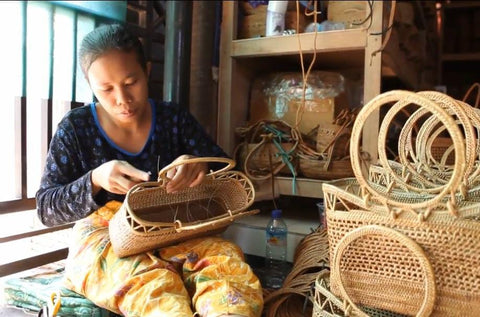How Are Bali Rattan Bags Made? The Making of Authentic Bali Rattan Bags
Are you a fan of the timeless Bali Rattan Bags that have been the talk of the town for a while now? These bags are perfect for any occasion, be it a beach vacation, a day out with friends, or a casual outing. The intricate details and mesmerizing beauty of the round rattan bags have caught the eye of many. But, have you ever wondered about the process behind their creation? In this blog post, we take you on a journey to the mesmerizing island of Bali, Indonesia, where skilled artisans pour their heart and soul into crafting these timeless treasures.

Is a Rattan Bag equal to Ata Bag?
The craftsmanship of the Bali Round Ata Bags has been passed down through generations in Bali, Indonesia.
While our by Ganapati are commonly called "rattan bags," it is a misnomer as the plant material used to make our bags is a type of reed vine called "ketak." It is also known as "Ata" (Ah-tah).
What is Ata? The material for making authentic Bali rattan bags
Firstly, it is essential to understand that while Bali Round Ata Bags are commonly called "rattan bags," it is a misnomer as the plant material used to make our bags is a type of reed vine called "ketak." It is also known as "Ata" (Ah-tah). The Balinese artisans have long used the Ata plant's leaf ribs and stalk as a source for making ropes, baskets, and various housewares.

The Balinese artisans have long used the Ata plant's leaf ribs and stalk as a source for making ropes, baskets, and various housewares.
To make a round rattan bag from scratch is very time-consuming. It could take up to one month to finish one rattan bag from scratch.
Preparing Ata vine for rattan bags
First, you need to collect the Ata reed vine and split it into 3-foot lengths for more comfortable weaving.

The artisans then wind thinner Ata fibers around sturdier strands to form long, rope-like weaving materials.

To facilitate the shaping process, We soak the strands in river water for a few days.
After the softening process, We then left the strands to dry to condition them properly.

Weaving Bali rattan bags
Weaving a rattan bag is a complex process that requires skill, patience, and attention to detail. Before the weaving process can even begin, the rattan must be properly conditioned to make it more pliable and easier to work with.
To condition the rattan, it is typically soaked in water for several days. This allows the fibers to absorb moisture and become more flexible. Once the rattan is fully soaked, it is laid out to dry in the sun. This can take several more days, depending on the climate and humidity.

Once the rattan is fully conditioned and dry, the weaving process can begin. A skilled artisan will take each individual strand of rattan and carefully weave it into a finished shape, using a combination of techniques and patterns. This can take several days, and in some cases, up to a week to complete, depending on the size and complexity of the design.
Throughout the weaving process, the artisan must pay close attention to the tension of the strands to ensure that the finished product is sturdy and durable. They may also add decorative elements or embellishments to the bag, such as colorful thread or beads, to make it more visually appealing.
Overall, weaving a rattan bag is a labor-intensive process that requires a high level of skill and craftsmanship.
Boiling rattan bags
Once the rattan bag has been woven into its finished shape, it is then boiled for an extended period of time to sanitize and disinfect it. This process typically takes up to 48 hours and involves boiling the bag in a large pot of water.
The boiling process serves several important purposes. First and foremost, it helps to kill any bacteria or germs that may be present on the bag's surface. This is particularly important in the case of rattan bags that are used for carrying food or other perishable items. By boiling the bag, the artisan can ensure that it is safe and hygienic to use.

In addition to sanitizing the bag, the boiling process also helps to make it more water-resistant. As the rattan fibers absorb moisture during the boiling process, they become more tightly packed and less porous. This makes the bag more resistant to water damage and can help to extend its lifespan.
Finally, boiling the bag can also help to make it more resistant to bugs and other pests. The high temperatures of the boiling water can kill any insects or larvae that may be present on the bag's surface, preventing them from causing damage or infesting the bag.
The boiling process is a critical step in the production of rattan bags. It helps to ensure that the bags are safe, hygienic, and long-lasting, making them a practical and functional choice for a variety of uses.
Drying Bali rattan bags
Once the rattan bags have been boiled and cleaned, the next step in the process is to dry them. The bags are typically placed outside in the sun to dry naturally, a process that can take several hours or even days, depending on the weather conditions.
During the drying process, it's important to ensure that the bags are not exposed to direct sunlight for extended periods of time, as this can cause them to fade or become discolored. Instead, the bags are typically placed in a shaded area, such as under a tree or covered porch, where they can dry slowly and evenly.
As the bags dry, the rattan fibers contract and the bag takes on its final shape. This is why it's important to carefully shape the bag during the weaving process, as it will maintain this shape during the drying process.

Once the bags are fully dry, they are inspected for any defects or imperfections. Any loose strands or uneven weaves are carefully trimmed or repaired to ensure that the bag is both sturdy and visually appealing.
The drying process is a crucial step in the production of rattan bags. Proper drying helps to ensure that the bags are both durable and beautiful, and it requires careful attention to detail to get it just right.
Smoking rattan bags in Oven
The bags are then smoked over coconut husks in a traditional oven for around 24 to 48 hours to impart their distinctive caramel coloration and continue the drying process.
This smoking process leaves the bag with a slight natural smokey scent that disappears over time.

Finishing
We sew on the buttons and straps and sew the traditional batik lining into the bag's interior for the last step.

All clips and straps are made of real leather. The button clips are woven into the bag's body, making them strong and firm and challenging to become detached.

After all of this effort, Voilà, a gorgeous Bali round rattan bag is born!

It Takes a Village to Make a Bali Rattan Bag
It is interesting to note that some villagers are better at making rectangular bags, and others are better at making round ones.

Some are good at making the finishing touches, such as sewing buttons and linings. As we said, it takes a village!
Ganapati Crafts Co. Supports Balinese Artisans
Ganapati Crafts Co. purchases these round rattan bags from the artisan group and sell them directly to you with no middle-men. By doing so, we can offer you the finest bags at an affordable price.
Furthermore, we make sure all weavers are fairly compensated which allows them to keep on following their passions while providing for their families.
We thank you for supporting the local Balinese artisans by wearing this beautiful bag!
Author

Yian Chang
Owner of Ganapati Crafts Co.
Yian, a Taiwanese Floridian, operates as a handicraft vendor, offering a range of charming and unique products including felt finger puppets, nursery decor, holiday ornaments, and handwoven bags. Be sure to visit Yian's brand, Ganapati Crafts Co., to explore her creative and one-of-a-kind creations.
